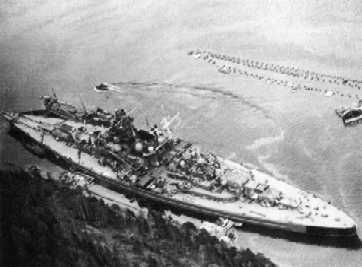Battleship Tirpitz
|
The German Battleship Tirpitz was built at Kriegsmarine Werft, Wilhelmshaven in Germany. She was laid down on November 2nd 1936, but it was April 1st 1939 before she was launched. Tirpitz was named after one Alfred von Tirpitz who was born in Germany in 1849. Alfred von Tirpitz joined the Prussian Navy in 1865 and rose through the ranks to become a highly decorated Grand Admiral from 1911 until his resignation in 1916. During his fifty-year career in the Navy, Alfred von Tirpitz made an enormous contribution to bringing the German Navy up to the fighting strength that it possessed at the beginning of the First World War. He died in Germany on March 6th 1930 The Tirpitz was commissioned on February 25th 1941 and placed under the command of Captain Friedrich Carl Topp. At the time of her commissioning, Tirpitz was the largest warship in the world, and she is still the largest warship ever to have been built in Europe. For the remainder of 1941 the Tirpitz underwent sea trials and training in the Baltic Sea, until on January 10th 1942 her Captain, Friedrich Carl Topp declared that she was fully operational. Tirpitz had a maximum displacement of 50,425 tonnes (February 1941). Her overall length was 832 feet (253.6m) and she had a beam of 118 feet (36m). The maximum speed she could travel was 30.8 knots and she had a range of 8,870 nm at 19 knots. The maximum machinery output was 163,026shp. Tirpitz was designed to carry six Arado Ar 196A-3 aircraft onboard, but she never carried more than four. In 1943 she had a crew of 2,608, comprising 108 officers, and 2,500 other ranks. The armament of the Tirpitz consisted of 8 main 38cm (15") guns situated in four twin turrets, 12 secondary 15cm (5.9") guns situated in six smaller twin turrets, 16 flak guns 10.5cm (4.1") The loss of the Bismarck in May 1941 forced the Germans to think very carefully about where to locate the Tirpitz. The German Grand Admiral, Erich Räder, was concerned about the amount of fuel required (there were shortages of fuel at this time), and with the fate of the Bismarck in mind advised against sending the Tirpitz to the Atlantic, opting instead to send her to Norway. It was hoped that by placing the Tirpitz in Norway she would tie down a significant amount of British warships in the Atlantic, which would otherwise have been used in the Mediterranean, the Indian Ocean and the Pacific Ocean. The Tirpitz, together with other German naval forces would be a threat to the Arctic convoys between Great Britain and Russia, and the convoys would need to be well protected by British warships. |
|
Tirpitz in Fættenfjord.
|
 |
|
Consequently, on January 14th 1942, the Tirpitz sailed to Norway, arriving in Fättenfjord near Trondheim on January 16th 1942. 33 air attacks were made against the Tirpitz during her lifetime. 32 of the air attacks were made by the Allies and one by the Russians. 16 of these attacks were in Germany during her construction, and a further 17 while she was in Norway. The British Navy also made an audacious attempt to sink her during her stay in Norway using midget submarines. The 33rd, and final air attack was made on November 12th 1944 when the Tirpitz was mortally damaged by the massive Tall Boy bombs designed by Barnes Wallis who was also responsible for the 'bouncing bombs' made famous by the Dambuster Raids of 1943. The Tirpitz capsized and sank in low water off Haaköya near Tromsö in Norway. Only about 700 of the 1,700 men onboard survived the sinking. The rusting hulk of the Tirpitz lay where she sank until she was eventually broken down for scrap between 1949 and 1957. |
© Linzee Druce 2001-2012